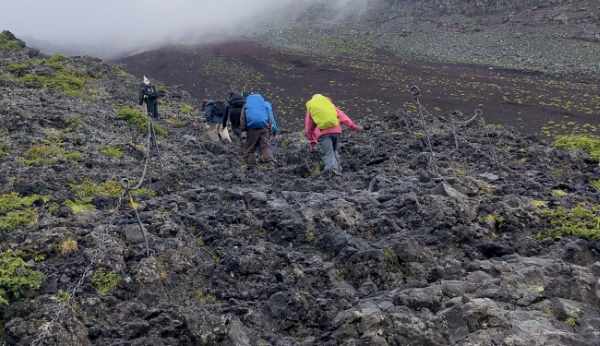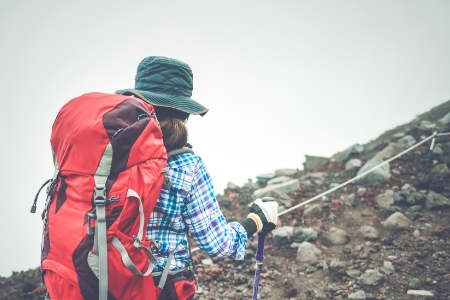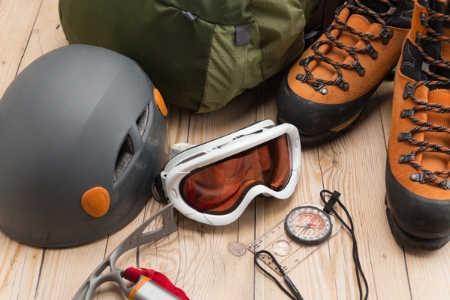Mt. Fuji Trivia
- Home
- Mt. Fuji trivia The Weather characteristics of Mt. Fuji
Don’t underestimate Japan’s Mountain Number 1!
The Weather characteristics of Mt. Fuji
There’s a big difference in the temperatures and weather between the summit and the foot of the mountain.
Mt. Fuji is an independent mountain with an elevation of 3,776m.
The winds from Suruga Bay and Sagami Bay and the winds from the north mix in a complex way, making the air currents unstable at high altitudes. In the past, the weather conditions were so severe that they caused airplane crashes.
The weather and temperature can vary greatly between the foot of the mountain, such as the fifth station, and the summit, and can even change suddenly. Be sure to prepare your gear in case of sudden weather changes, and be sure to check the weather information before starting your climb. Don’t forget to check Imafuji’s weather observation information.
And it’s also important to have the courage to abandon your climb when the weather is bad.
(Navigator: Imafuji Grandpa)


Temperatur
|
month |
average temperature(℃) |
daily maximum temperature(℃) |
daily minimum temperature(℃) |
humidity(%) |
|---|---|---|---|---|
|
July |
5.3 |
8.0 |
2.8 |
79 |
|
August |
6.4 |
9.5 |
3.8 |
75 |
|
September |
3.5 |
6.5 |
0.6 |
67 |
*Japanese Meteorological Association Mt. Fuji (Shizuoka) statistical period 1991 – 2020
Average Temperature on Mount Fuji’s Summit Over 30 Years. The table above shows the average temperatures at the summit of Mount Fuji over the past 30 years. In July and August, the temperatures range from 5°C to 6°C.
Due to the significant elevation difference between the Fifth Station and the summit, there is a substantial temperature drop (approximately -0.65°C for every 100 meters of elevation gain). This means that even in summer, the summit can have temperatures comparable to midwinter conditions. Calculations show that the temperature at the summit can be 25°C lower than at sea level. Therefore, even for summer climbs, warm clothing is necessary.
Furthermore, wind can make it feel even colder, with the wind chill effect lowering the perceived temperature by about 1.0°C for every 1 m/s increase in wind speed.
In the early morning hours before sunrise, the temperature can drop close to 0°C. Even during the summer climbing season, snow can fall and accumulate if the weather conditions are right.
Waiting for the sunrise for extended periods increases the risk of hypothermia. If your clothes get wet from sudden rain, your body heat can be rapidly lost.
It’s advisable to avoid cotton undergarments and opt for quick-drying synthetic materials instead. Also, don’t forget to bring waterproof and breathable rain gear, preferably with separate tops and bottoms made from materials like Gore-Tex.

Wind
Mt. Fuji’s summit holds the nationwide record for the highest wind speed!
Maximum boe speed 91m/s (25.9.1966 due to typhoon Nr.26 approaching)
Maximum wind speed 72m/s (5.4.1942 due to low pressure system)
*Maximum boe speed is the highest measured speed at any moment. The maximum wind speed is measured over a period of 10min.


Mount Fuji is the highest mountain in Japan, making it particularly susceptible to direct impacts from high-pressure and low-pressure systems, as well as typhoons. Because of its elevation, strong winds can occur even when a typhoon is still far away, so climbers must remain vigilant.
As previously mentioned, wind can significantly lower body temperature. The climbing routes on Mount Fuji have little to no forest cover to block the wind. This exposes climbers to the elements almost continuously. When staying overnight at a mountain hut and ascending during the night to witness the sunrise at the summit, or during climbs in rainy conditions, it’s crucial to take measures to retain body heat.
Special caution is needed during weather conditions when both wind and rain are present, as these can lead to dangerous situations.
To avoid hypothermia caused by wind and getting wet, choosing appropriate clothing that prevents body heat loss is essential.
If there are signs that the weather is worsening, it’s best to cancel the climb.
Active volcano

Mount Fuji remains an active volcano, continuing its volcanic activities.
To prepare for sudden eruptions, it is recommended to bring essential safety equipment such as helmets, masks, and goggles.
Always stay informed about the current volcanic alert levels. If the alert level is raised while you are climbing or descending, you should immediately head down the mountain.
For the latest information on volcanic activity and alert levels for Mount Fuji, please regularly check the Japan Meteorological Agency’s website under the section “Volcanic Activity Information (Mount Fuji).”
Japan Meteorological Agency: Mt. Fuji Activity Status and Lightning Warning
references
- Ministry of the Environment Mt. Fuji Official Site
- Full Observation of Mt. Fuji(Koki Kamada ISBN978-44-416-11370-7)



